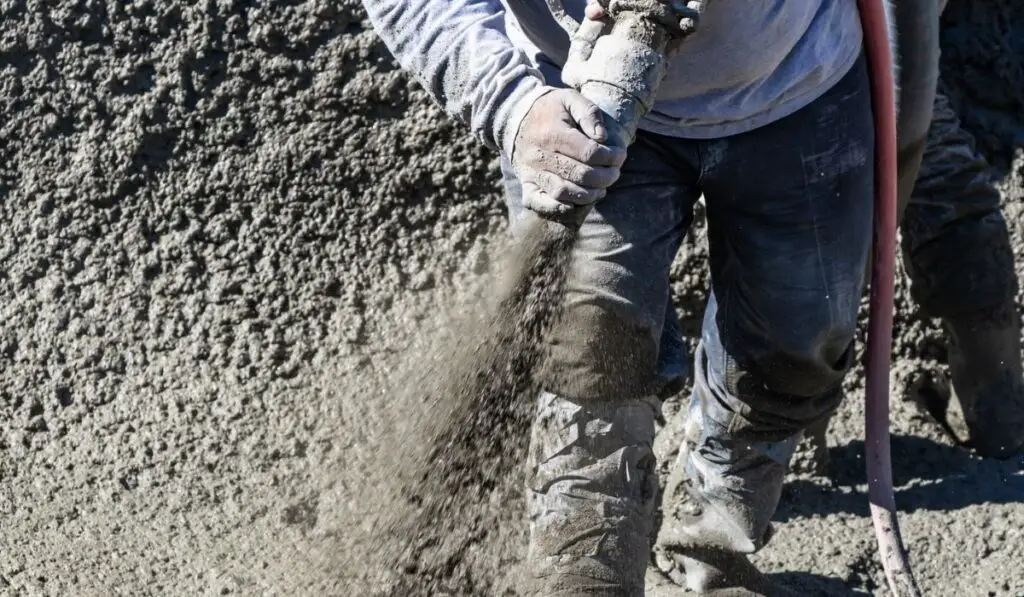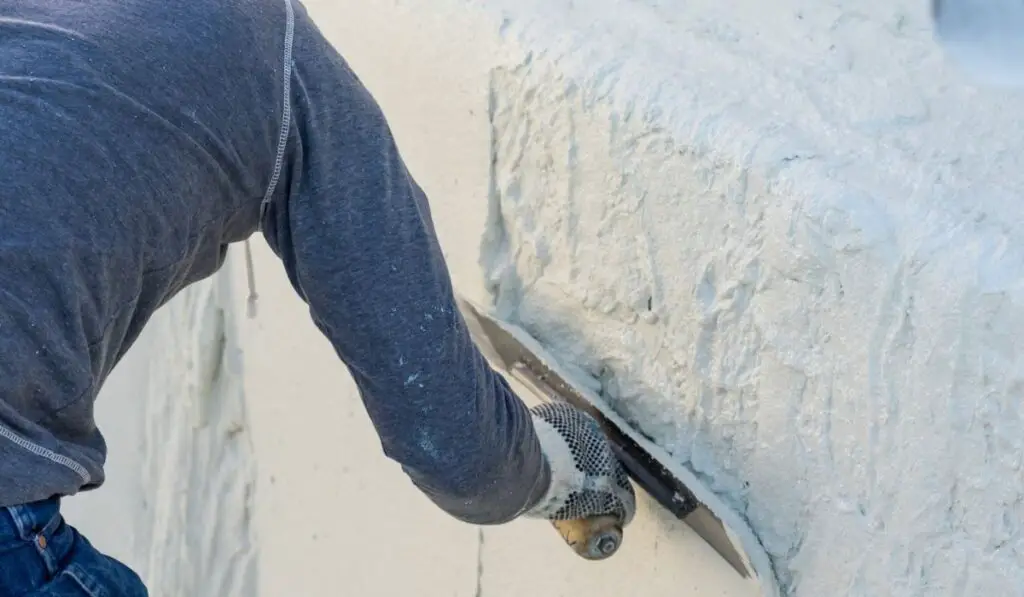When making the decision to install an in-ground concrete pool in your yard, it’s easy to get caught up in the distinctions between the different materials available. So if you’re wondering whether gunite and plaster are the same thing, you’ve come to the right place.
Gunite and plaster are used together in the construction of in-ground, concrete pools but for different purposes. Gunite is sprayed over a steel frame to make the pool floor and walls, while plaster is the finishing compound sprayed on the gunite shell. Then water goes in the plaster shell.
Let’s take a closer look at gunite and plaster pools to get a clear understanding of their similarities and differences. While the gunite part of a pool needs to be installed by professionals, the plaster coating on the interior is something you can manage yourself (if you’re comfortable with that type of project).
What Is Gunite?

Gunite is a type of dry concrete mixture made up of sand and cement. Water is added to it as it exits a high-pressure hose to make a slurry that is sprayed onto the permanent steel rebar framework that holds the pool’s shape.
Gunite is sprayed in a pressurized form rather than being poured to make sure there are no seams in the pool structure. Spraying also allows for maximum design potential and maximum coverage, even on vertical surfaces.
Gunite’s dependable structural strength, design flexibility and durability have made it a popular pool construction material for decades.
How Long Do Gunite Pools Last?
Gunite pools are stable, steel-reinforced, concrete structures that are built to last, with many willing to quote 100yrs as the life expectancy. Obviously this assumes good, effective maintenance! The key to their longevity is their ability to endure both internal and external force thanks to a high tensile fortitude and flexibility.
The gunite shell can handle shifting soil caused by earthquakes and ground-water movement without crumbling and is therefore able to last for many years.
The only threat to the longevity of a gunite pool is harsh weather and imbalanced pool water chemistry. Sunlight and pool water contribute significantly to the breakdown of the gunite shell.
Most gunite pools require resurfacing every seven years. Adding a tile or pebble finish may increase the longevity of a gunite pool.
What Are the Pros and Cons of Gunite Pools?
Before investing in a gunite pool, you should consider its pros and cons. Here is a list of the most common ones:
Pros of a Gunite Pool
- Durability: Durability is one of the most important qualities of gunite pools. Gunite pools do not damage easily, and they last for a very long time.
- Design flexibility: Pool design options cross the full spectrum when it comes to gunite. From smooth curves to sharp angles, gunite delivers. Since the pool is built on-site, you can include a myriad of design features to suit your yard, lifestyle, budget, and style preferences.
- Longevity: Gunite pools are built to last thanks to the strength of materials used in their construction.
- Customizable finishes: Gunite allows pool owners to optimize the visual appeal of their pools with customizable finishes. You can use colored plaster, pebble, quartz, glass, or tile finish to add beauty to your pool or dramatic appeal to your pool water.
- Depth: Gunite pools can be sank to great depths thanks to a strong steel-reinforced shell. This allows for the introduction of diving boards.
- Additional features: From elevated spas to waterfalls, a range of custom add-ons can be incorporated into a gunite pool to create a private aquatic resort of any configuration.
- Improved home value: According to experts, a substantial concrete pool is a great selling point for a home. Installing a gunite pool to your yard will significantly improve the value of your home.
Cons of a Gunite Pool
- Lengthy construction: You’ll have to endure the sight of your torn-up backyard for months since gunite pools are built on site from the initial hole digging to adding a finish at the end. How long the construction takes depends on the complexity of the design.
- High maintenance costs: Weekly scrubbing to remove surface algae and regular addition of muriatic acid to regulate pH makes for high maintenance costs. Due to deterioration over time, pool resurfacing must be done every seven years. These maintenance costs make the lifetime cost of owning a gunite pool quite high.
- Comfort and Safety: The rough surface of gunite pools makes swimming uncomfortable, especially for children. Brushing wet feet against this abrasive surface is also likely to cause irritations and scrapes.
- High operation costs: Metals and alkaloids leaching from the pool’s frame force the filter to work overtime, which increases the operation costs.
What Is Plaster?

Pool plaster like this (example on Amazon) is a finishing compound that is used to coat the inside walls of a concrete in-ground pool. It’s applied for several reasons including giving the pool a smooth texture and, more importantly, creating a watertight seal to separate the water from the concrete.
The plaster is typically made of a mixture of white sand and white cement. It’s mixed with water to make a slurry and sprayed on the concrete shell of the pool to create a thick layer that is then troweled smooth. The plaster is quick-drying, and it only takes a day before you can fill the pool with water.
Plaster is relatively inexpensive compared to other finishes but weekly surface maintenance to remove algae and acid washing every 3 to 5 years makes it more expensive in the long run. Plaster is also rough to the touch and is prone to cracking, staining, and scaling if not properly maintained.
The standard white pool plaster also known as marcite, gives your pool water the classic sky-blue tint that is simple yet classy. The plaster can be dyed with different colors or blended with pebbles and quartz to amplify the pool’s appeal and improve durability.
How Long Does Plaster Last in a Pool?
Unfortunately, plaster doesn’t last forever. It lasts for an average of 9 to 12 years. However, there are several variables that can increase or reduce this timeframe.
Imbalanced pool water chemistry, debris, plaster thickness and cracks can compromise the plaster’s integrity and reduce its lifespan. On the other hand, proper pool care and maintenance can improve the plaster’s longevity.
There are telltale signs that your pool needs to be replastered or at least patched. These include the following:
- Mineral stains: When minerals in the pool water, such as copper and iron, stain the plaster, it’s time to replace it. Acid washing can remove the stains but only to an extent.
The stains that call for replastering give the pool a brown or dirty green color and typically take years to show. Stains appearing after a year or two are probably not from aged plaster.
- Uncomfortable swimming: When you notice lumps, bumps, or jagged plaster on the walls, it’s a sign that your pool’s plaster is wearing thin. The uneven surface helps algae thrive and makes it harder to clean the pool. You should not wait until you’ve scraped your foot, hand, or knee before you replaster.
- Gunite showing: Plaster becomes translucent as it wears thin. Patches of darker material may therefore be exposed gunite showing through. This is an indication that you should replaster immediately to avoid compromising the structural integrity of the pool.
How Thick Is Swimming Pool Plaster?
Since pool plaster is the skin separating concrete from the water, it must be thick enough to prevent water leakage and surface cracks. However, it doesn’t have to be as thick as the gunite layer, which forms the pool basin’s structural support. The ideal plaster thickness is typically between 3/8 and 5/8 inches.
Ultimately, the thickness of swimming pool plaster depends on an individual’s preferences and the state guidelines. When deciding the thickness of your pool plaster, you should know that thicker plasters tend to last longer.
What Are the Different Types of Pool Plaster?
Plaster is arguably the most common finishing compound applied on both regular poured concrete and gunite pools. That’s because it’s very affordable and easily available. There are several plastering options in the market today that fit different price points, styles, and color options. These include:
White pool plaster: White is the standard finish for most swimming pools, mainly because it’s the most affordable option. It’s made up of a mixture of white sand, white cement, and water.
Finely crushed white marble sand can be used as an alternative of white sand to create white marble plaster. White pool plaster has a short lifespan of 9 to 12 years.
Colored pool plaster: Colored plaster is made by adding colorants or colored aggregates to white plaster. It changes the appearance of the pool water and adds a dramatic appeal to the pool.
It’s also an affordable option but tends to streak, mottle, and fade with time. You can, however, use the mottling effect to enhance its beauty.
Aggregate plaster: Aggregate finishes provide pool owners with more design options. They combine white or colored plaster with glass beads, river stones, granite, or quartz to produce an attractive and luxurious pool finish.
Aggregate plasters also have superior stain resistance and a longer lifespan of up to 20 years thanks to their nonporous surface. For all these advantages they tend to cost more to install.
Aggregate Plaster options include:
- Quartz plastering finishes: Produces a safe, non-abrasive, slip-resistant surface for your swimming pool. Being one of the world’s most durable minerals, quartz provides an unfading beauty that lasts for years. A quartz plaster finish has a lifespan of between 9 and 15 years.
- Pebble plastering finishes: This is one of the most luxurious aggregate plastering options in the market today. It’s more costly than standard plaster or aggregate quartz plastering thanks to its very high quality. With proper care and maintenance, a pebble plaster finish can last for more than 20 years.
- Glass plastering finishes: The reflective quality of glass allows glass finishes to achieve the shiniest and brightest pool finishes on the market. Glass finishes are common, but they are typically combined with quartz. The amount of quartz used depends on the brand.
Final Thoughts
Gunite and plaster pools may refer to the same pool type because they are typically used together in the same in-ground pool.
Gunite is used to make the pool shell that holds the water. It is supported by a steel frame to give it strength and durability.
Plaster is the finishing mixture that is layered over the gunite shell for waterproofing and to give the pool a smooth texture. Plaster can be dyed with a range of colors or aggregated with pebbles and quartz for improved durability and visual appeal.
